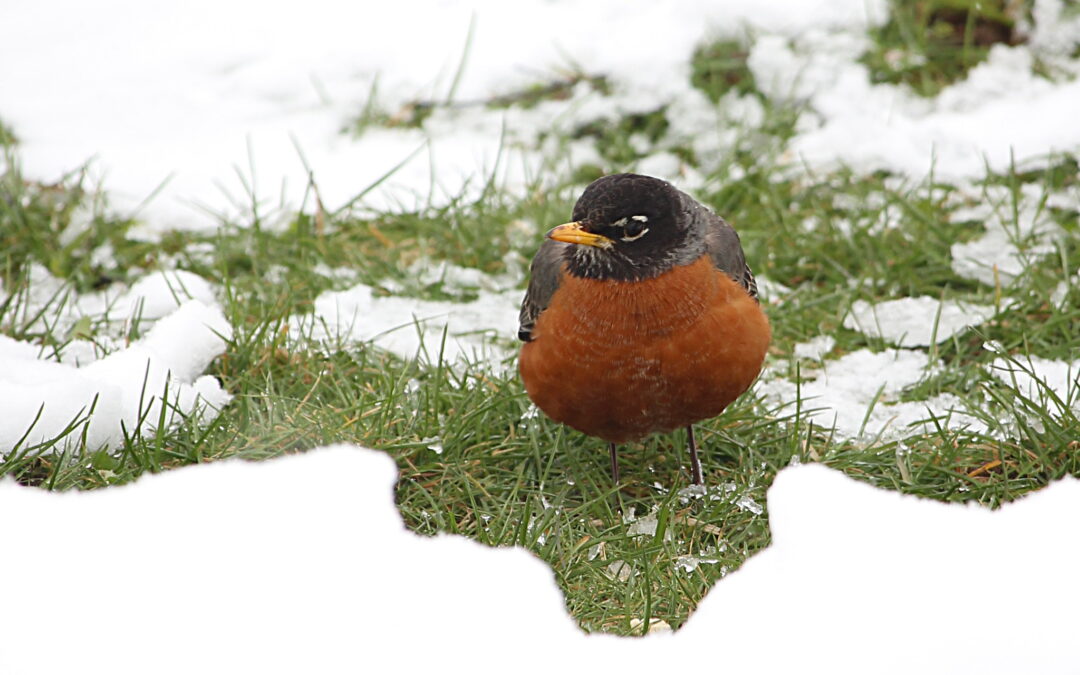By Emma Roth
Robins aren’t always thought of as a very exciting or interesting bird. They are easy to find and identify, often spending time in backyards scratching at the ground for worms. I have a bit of a soft spot for robins. They are one of the birds I can reliably identify (I’ve never been a birder, something I hope to change one day), and they are often connected with the return of spring, my favorite season.
My attitude towards robins has changed somewhat in the past few weeks, as one particularly annoying robin has decided that my car mirror is a prime perching location. As such, this bird has done a fantastic job of white washing my mirror and the side of my car. I cleaned my car three times before I admitted defeat. That mirror belongs to the bird now.
Since this battle has begun, I’ve found myself looking more harshly at these birds that have, up until now, been a welcome sight. That’s not fair to them, so I’ve decided to get to know them better and learn some new things about them in the hopes I can repair our relationship.
A few months ago, I was teaching a classroom program when a student asked me how robins got their name. I had no idea, so I told the student I would have to do some research. Now seems the perfect time to look into it and get that answer.
It turns out the bird we know as a robin is not the original robin. Early European settlers named the American Robin after the European Robin. These two birds, while only distantly related, are both gray-brown with orange chests. European settlers saw the resemblance and decided to use a shared name to remind them of home. However, this just creates another question. Why is the European Robin named Robin?
In the 15th century, people developed a bit of an odd tradition. They decided to name animal species using human names. During this time people also seemed to be fans of alliteration. The robin began to be called Robin Redbreast for its distinctive coloring. This is a little strange as the chest of the European Robin is clearly orange, not red. However, calling orange animals “red” is fairly common (Red Fox, Red-breasted Nuthatch, even red hair on humans is more orange than red). Most of these animals were named before the word “orange” was used to describe the color, and “red” was the standard word for any color on that orange-red spectrum.

Now that we have that question answered, it’s time to turn back to the American Robin. As noted before, robins are often thought of as signs for spring. However, this past winter, my first winter living in Jamestown and experiencing the wonderful winter weather it has to offer, I noticed there were still plenty of robins around. Instead of seeing them scratching the ground, I began to notice them up in the trees.
I had become so accustomed to looking for robins on the ground, I had never really thought to look up in the trees. I don’t know why that changed this year. Maybe it was the nice second-floor view from the Audubon staff offices, or maybe because I had just moved to a new city and was just more observant as I took in new sights, but I saw the robins everywhere. Little balls of fluff patiently waiting in the branches for spring to come.
During this time the ground is covered in snow and the worms are safe in the frozen earth below. Robins rely on eating the remaining berries from bushes and trees, such as sumac, while they wait for the snow and ground to thaw to begin hunting worms. If it gets cold enough, or the snow deep enough, they will move off and find somewhere a little warmer, but they don’t stay away for long, and they certainly don’t leave for the entire winter, only returning in the spring.
So while I may still be annoyed at the robin sitting on my car, I can now appreciate both the historical story behind its name and its hardiness for surviving these Jamestown winters. It may take some time for my relationship with robins to be fully repaired, but I believe I am well on my way. When my robin friend moves on from my car to find a new perch, I may even miss him a little.
Audubon Community Nature Center builds and nurtures connections between people and nature. ACNC is located just east of Route 62 between Warren and Jamestown. The trails are open from dawn to dusk as is Liberty, the Bald Eagle. The Nature Center is open from 10 a.m. until 4:30 p.m. daily except Sunday when it opens at 1 p.m. More information can be found online at auduboncnc.org or by calling (716) 569-2345.


Recent Comments